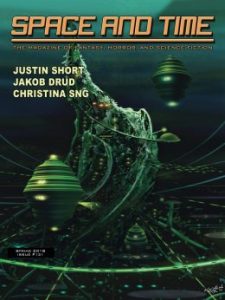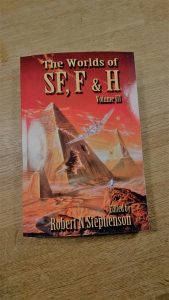You learn new things when you leave your comfort zone, and that’s just what I did while participating in this year’s National Novel Writing Month. I thought I’d share my experiences in case anyone wanted inspiration for increasing their productivity.
But what is National Novel Writing Month (orNaNoWriMo for short), and how does it put you under pressure? Well, it’s a challenge that takes place every November, and the goal is simple yet not easily attained: Write 50,000 words of fiction in 30 days.
Officially, those words are supposed to become a novel, but nobody is looking over your shoulder. You do it for the challenge, and if you end up writing an epic poem instead of a novel, you still win. Even if you only write 10,000 or 25,000 words, it’s progress on your writing project. You won’t get a winner’s certificate, but that’s not the point. The point is to write more and push your limits.
50,000 words amounts to 1,667 words every day, or if you’re like me and don’t write on weekends, it’s 2,272 words per weekday. For some, that may be a piece of cake, but for me it means I have to push myself beyond my usual writing pace.
So what did I learn?
1 – Forcing Productivity Increases Creativity
You have to know where your story is going to write it, right?
Except, during NaNoWriMo you may running short of material and good ideas during the process. Perhaps you wrote down all the good ideas, or perhaps the plot took an unexpected turn, leaving you with an outline that no longer makes sense.
On those days, I nevertheless sat down and reread what I had written yesterday, and started typing new words. And sometimes, the most outrageous ideas would arise after I had typed for a while. I would suddenly know how to solve a problem that I’d struggled with by deviating from the plan, and this would take the story in directions I hadn’t even wondered about before.
These sparks were usually connected to new insights about the characters and the worldbuilding rather than plot, but that didn’t matter. When I found new depths in the characters, they’d also face their situation in a new way, and that led to unexpected plot twists.
Sometimes nothing new came from all that typing. However, the great thing about NaNoWriMo is that every word counts, and if you end up writing something that’s not a good fit for the story, you can always start that scene over, or make up a new one. Getting the ‘wrong’ scene out of the system paves the way for the ‘right’ scenes.
So you can’t write bad words during NaNoWriMo. You can only write words. That takes away the frustration that usually hits me if I’ve worked an entire day on a scene that I suspect I’ll have to throw out later.
2 – Listen to Your Mind
A few days into NaNoWriMo I found that I could stop typing, but I couldn’t put my mind on hold. The creative energies were boiling even when I wasn’t writing. Brilliant!
I’m used to having ideas pop up and demand to be written. Grasping those idea when they surface is actually a skill I’ve tried to hone over the years, because the better ideas often rise up from the subconscious — all have to do is listen to them. During NaNoWriMo, I learned to listen just a little harder, and I think I became a little better at catching those subconscious curveballs. This is extremely useful for a writer, and I can still feel the benefit from this even though NaNoWriMo is over.
There’s a trade-off to being this deeply immersed in a project though. I’m much less sociable when I’m in my own headspace. During November I could feel my mind wandering when I was with other people, and for me that’s not a healthy habit, so I’m also glad it’s only NaNoWriMo once a year.
3 – Work Smarter Not Harder
I’m usually somewhat impatient with my work. When I write something, I want to finish it, get it out of the way and work on the next project. Finish a scene, finish a short story, finish a novel, just finish it. But I already knew that I wouldn’t finish the novel in November (it’ll be about 110-120K words in all), so I might as well adjust my expectations and try out a new way of working.
For me, working differently this November meant switching between projects several times per day.
Early in November I decided to alternate between two novels. The result was that I wrote about 10,000 words on a co-written project and 40,000 words on a solo project.
I also switched between scenes. My solo project has three point of view characters, so I could always switch to a different way of seeing the world if I got stuck.
In effect I threw away my impatience–never mind finishing a scene today, I could always do that tomorrow. Both types of switcheroo worked like a charm. Getting into a different mindset proved refreshing, and often resulted in a new burst of words. I’d do this perhaps four times per day, ending up with chunks of 400-700 words every time, and sometimes more.
It’s a practice I’ve chosen to continue in December, and it works like a charm. Maybe it’s because I had a ton of minor projects waiting for me after November, but it still feels more efficient.
4 – Timing is everything
Around mid-November I had fallen a little behind, and so my daily word count had to go up if I were to make it. And if 2,272 words per day look intimidating, try looking at 2,600.
For this I turned to the Pomodoro technique of writing 25 minutes at a time, followed by a break. This had the nice effect of breaking the work into manageable chunks, because anyone can write for 25 minutes, right? It turned out I could, at least, and those sessions typically yielded 4-500 words. Suddenly all I had to do was write 5-6 times a day. While this was still high-intensity work, it nevertheless became much easier.
Incidentally, once I started timing those sessions, I discovered that my attention would start to wander after 22-23 minutes of writing, so taking a break turned out to be a good idea.
In conclusion, I can say that I’ll be using what I’ve learned in the year to come – and that I hope to be under considerably less pressure.
And also, if you have any productivity tricks up your sleeve, I’d love to hear about them in the comments.

 Once again I have the pleasure of having a story in an anthology from the series Worlds of Science Fiction, Fantasy & Horror, edited by Robert N Stephenson. The series distinguishes itself by collecting stories from writers in many different countries, many of them exciting new names in the speculative genres.
Once again I have the pleasure of having a story in an anthology from the series Worlds of Science Fiction, Fantasy & Horror, edited by Robert N Stephenson. The series distinguishes itself by collecting stories from writers in many different countries, many of them exciting new names in the speculative genres.


